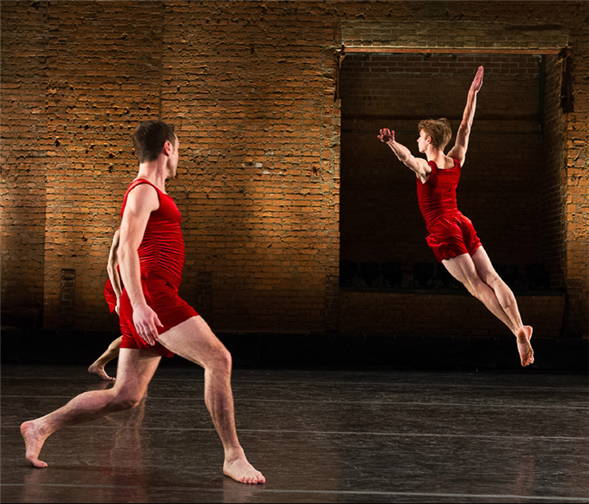Translate Page

How the choreographer teases our idea of meaning and narrative
---
The choreographer Pam Tanowitz is setting herself plenty of challenges with her second season at the Joyce Theater, which plays February 18-21. Two years ago, she presented a concise, continuous program: two works (plus a transitional "pause dance") performed with no break, all taking place in an hour.
Now she's operating on a more expansive scale. To begin, there's her Joyce-commissioned world premiere, the story progresses as if in a dream of glittering surfaces. The piece took on its own dimensions as she choreographed it, expanding beyond her initial intentions.
"I thought it would be a half hour," Tanowitz says. "Now it's 52 minutes! It just means that I'm pushing myself, and I'm just going to go with it. A lot of the piece is about reversing, going backwards to go forwards, and replacing people. That's a theme throughout. I was able to go deeper into the piece, and push it out from the inside. Maybe that's how it got longer."
The work is built around two contrasting scores, and fortunately, as it has grown, the composer providing the electronic portion has been accommodating to Tanowitz's requests for additional music. (That composer is Dan Siegler, her frequent collaborator and also her husband).The shorter, first section of the dance is set to Julia Wolfe's Four Marys, to be performed live by the FLUX Quartet.
But even though it's longer, the story progresses… is actually much more spare than Heaven on One's Head, which Tanowitz brings back to the Joyce to conclude the program. While the new piece employs just five performers, the older work sets nine dancers darting through the space in constantly varied groupings—evoking shifting landscapes to the edgy sonorities of two string quartets by Conlon Nancarrow.
The new piece's relative sparseness may be a sign of what's to come. "She's allowing more space for things to happen," says Melissa Toogood, who's performed with Tanowitz regularly following her years with Merce Cunningham's company, and is also the troupe's rehearsal director. "When she made Broken Story last year for the Guggenheim, it was the first time I didn't have to pack so many steps into a specific amount of time. It was a good challenge for me, to do more with less."
Tanowitz has firmly established herself as a brainy, inventive, strongly individual choreographer whose work utilizes the ballet vocabulary but takes it in intriguing directions. Critics have noted an affinity between her dances and those of Cunningham, whose boldly innovative choreography insisted that movement not be "about" anything other than itself.
"I think the connection between her and Merce is how much they both love the steps," observes Dylan Crossman, who has performed in Tanowitz's work since 2008 – before, during, and after his membership in Cunningham's company. "There doesn't need to be anything artificially added to it. They're both interested in what story the body can tell on its own."
Asked about storytelling in her work, Tanowitz says, "I like to have it both ways, if I can. It's always going to be about movement. But that space between movement and meaning – that's interesting for me to explore. Is there narrative or drama within that space?"
Speaking of narrative, she even found the title for the story progresses... while reading a book about French New Wave cinema. However, rather than trying to relate any specific "story," she let her awareness of the dancers' individual qualities – and how they interact with each other – propel the piece's development.
"She always has something in the back of her mind -- a text she's read, an experience she's had – and she doesn't always talk to us about it, which is very like Merce," Crossman says. "And I don't necessarily want to know what they think it's about. Because I have my own idea of what it's about, for me."
Toogood appreciates the degree of self-reliance that Tanowitz allows her dancers. "Pam's had a very clear artistic vision for a long time. She's very much herself. She always starts with structure for every piece and fills it in from there. I feel like I can use all of my training in her works. My ballet training is relevant, and even my jazz and tap. I can bring the best parts of it all into her work in a way that's new and interesting to me."
---
TDF Members: At press time, discounted tickets were available to the Pam Tanowitz Dance series. Go here to browse our current offers.
Susan Reiter writes regularly about dance for TDF Stages.
Photos by Christopher Duggan.